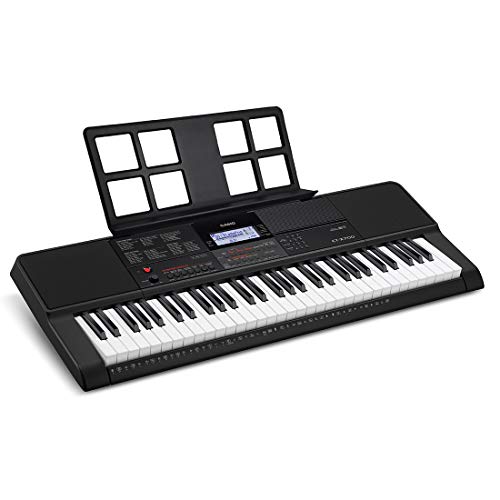

The key to quickly learning to play the piano like a pro is to choose the right beginner keyboard – and to help you with that decision, in this article we compare two of the most popular, beginner-level, and budget-friendly keyboards: the Casio CT-X700 vs Yamaha PSR E363.
While both of these digital keyboards come from leading keyboard manufacturers and seem like great options, there are certain areas where one of them will be a better fit for your situation.
Table of Contents
- Casio CT-X700 vs. Yamaha PSR E363 Specifications Compared
- Major Similarities Between Casio CT-X700 vs. Yamaha PSR E363
- Major Differences Between Casio CT-X700 vs. Yamaha PSR E363
- Casio CT-X700 Summary
- Yamaha PSR E363 Summary
- Casio CT-X700 vs Yamaha PSR E363 Comparison by V Rock and Pop Musical
- Conclusion
Let’s dive into an in-depth look at the Casio CT-X700 vs. Yamaha PSR E363!
Casio CT-X700 vs. Yamaha PSR E363 Specifications Compared
The specifications of the Casio CT-X700 and Yamaha PSR E363 have been compared in the table below:
Major Similarities Between Casio CT-X700 vs. Yamaha PSR E363
Both the Casio CT-X700 and Yamaha PSR E-363 are equipped with features that are ideal for beginners. Although they belong to different manufacturers, they’re quite similar in numerous areas. Both the Casio CT-X700 and Yamaha PSR E363 are equipped with 61 touch-sensitive keys. It means that you can enjoy the feel of a real acoustic piano at a fraction of cost. The harder or softer you press the keys, the louder or softer the sound will be. Moreover, they both also feature a 48-note polyphony, making their sound quality quite similar.
The Casio CT-X700 and Yamaha PSR E363, both feature an LCD display that makes it easier for the user to navigate through the numerous operations and keep track of keyboard settings.
Another noticeable similarity between the Casio CT-X700 and Yamaha PSR E363 is that they both have a Duo feature that divides the keyboard into two equal halves, making it possible for two people to play the keyboard at the same time. It is ideal for beginners who have a piano teacher teaching them to play.
There is an in-built recorder in both the Casio CT-X700 and Yamaha PSR E363. The number of tracks that can be recorded varies. Other important similarities between these two beginner-level keyboards are that they both feature USB to Host input and support pedal input as well. They both have a headphone jack as well, along with 2 in-built speakers of 2.5 watts each.
It looks like the Casio CT-X700 and Yamaha PSR E363 are quite similar to each other. However, as we mentioned in the beginning, there are certain aspects where the two differ. Let’s have a look at what these differences are.


Major Differences Between Casio CT-X700 vs. Yamaha PSR E363
The primary difference between the Casio CT-X700 lies in the repertoires and the number of sounds, demo, and pre-recorded songs and rhythm styles. The Casio CT-X700 has the edge over the Yamaha PSR E363 in this area, with 600 different sounds compared to 574 sounds in the Yamaha PSR E363. Moreover, the number of pre-recorded songs in both is also different. The Casio CT-X700 has 160 pre-recorded songs, whereas the Yamaha PSR E363 has 154 demo songs. The number of rhythms also differs from the Casio CT-X700 equipped with 195 rhythms and the Yamaha PSR E363 equipped with 165 rhythm styles.
The Casio CT-X700 has a greater recording capacity as compared to the Yamaha PSR E363. Casio CT-X700 can record up to 6 songs, whereas the Yamaha PSR E363 can record 5 songs.
There are certain aspects where the Yamaha PSR E363 has an advantage over the Casio CT-X700, including 26 types of harmony, 150 types of arpeggio, and 9 slots of registration memory. In comparison, the Casio CT-X700 has 12 types of harmony, 100 types of arpeggio, and only 4 registration memory slots.
Another noticeable difference between the two is that the Yamaha PSR E363 features AWM sound technology, whereas the Casio CT-X700 features the AiX sound engine, which is relatively better than the one used in Yamaha.
Casio CT-X700 Summary

Major Features
|
FEATURE |
DESCRIPTION |
|---|---|
|
Keys |
The Casio CT-X700 features 61 touch-sensitive keys that make it easier for the user to get accustomed to the hand movements that are required to play the full-size 88-key keyboard. The touch-sensitivity delivers the feel of an actual acoustic piano, thereby enhancing the keyboard playing experience for the users. The keys of the Casio CT-X700 aren’t weighed; thus, they lack the strength of an acoustic piano. |
|
LCD Display |
The Casio CT-X700 features a pretty large LCD display which offers the users a great visibility at all times. |
|
Sound Quality |
The Casio CT-X700 features the AiX sound engine along with DSP processing that provides exceptional voices and instrument tones. It also enhances the sound of brass, strings, wind instruments and produces a sound of excellent quality and appealing tones. |
|
Keyboard Functions |
It has a rich library that consists of voices of numerous instruments, music, and built-in accompaniment styles. A wide range of chorus, reverb, harmony, and other sound effects allows the user to customize the sound of their instrument. |
|
Learning Features |
Since the Casio CT-X700 is targeted to help beginners get accustomed to the piano playing skill, it features some great learning features that help the user learn all the necessary basics. It comes with a Step-up Lesson system that takes the user through songs chord by chord, phrase by phrase, or hand by hand at whatever pace the user is comfortable with. It also features a melody suppression system that enables the users to play any song from the onboard library while suppressing the memory so that you can play along with your favorite songs through the audio input. |
|
Connectivity |
The Casio CT-X700 features a GM level 1 MIDI format and USB that allow the users to pair their Casio CT-X700 keyboard with their tablet or other devices and augment their ability to learn to play the keyboard, record their songs, mix music and share their performances online. It allows you to add your favorite songs and store them for future playback on the keyboard. It helps you identify the areas where you need to improve and hence, aid you in learning to play the keyboard like a pro! |
|
Speakers |
It comes with two 2.5 watt speakers that allow the user to play their songs out loud, especially if you’re planning to play the keyboard during a small party with your family and friends. |
|
Additional Features |
The Casio CT-X700 comes with a port for sustain pedal, allowing the users an opportunity to upgrade their keyboard playing experience. The headphone jack allows the users to practice in silence. In short, it has everything that you’ll need as a beginner to get your hands on the keyboard playing skills with ease and comfort. |
Pros & Cons
Pros
- Touch-sensitive keys
- Sturdy
- Numerous rhythm styles and tones
- Great sound quality with AiX sound engine
- A large LCD display
- Easy to use
- Lightweight and portable
- Sounds and effects of other musical instruments
- In-built song library
- Great learning features
- USB and MIDI connectivity
- Headphone jack
- Port for connecting pedal
Cons
- The plug is bulky
- The keys are non-weighted
- The appearance is not very appealing
The Bottom Line
The Casio CT-X700 is one of the finest keyboards that a beginner can opt for. With superior sound quality, a rich music library, and numerous rhythm styles and instrument sounds, the user is sure to enjoy a professional-like performance at a very affordable, or rather, a low price!
Yamaha PSR E363 Summary

Major Features
|
FEATURE |
DESCRIPTION |
|---|---|
|
Keys |
The Yamaha PSR E363 features 61 touch-sensitive keys that give you the classic piano feel. One of the features that make this keyboard a great option for beginners is the Touch Tutor that helps beginners learn the dynamics of playing the keyboard and analyze the velocity of their keystrokes. It helps novices get a grip on their keyboard playing skills faster. |
|
Duo Feature |
The Duo feature is one of the most important features of the Yamaha PSR E363. It divides the keyboard into two equal halves with a separate middle C key, making it possible for the user to practice with their teacher or partner. |
|
LCD Display |
The Yamaha PSR E363 features a large LCD display with a backlight, which makes it possible to use the keyboard even in a low light environment. |
|
Learning Features |
Other than the Touch Tutor, the Yamaha PSR E363 is equipped with Keys to Success, which is a compilation of keyboard playing techniques. The step by step guide helps the beginners to play the complete song without much difficulty, hence enabling them to learn to play the piano in no time!
That’s not all. The Yamaha PSR E363 also features the education suite that gives beginners an effective, simple, and convenient learning package. It comprises of lessons for playing the piano using a single hand or both hands. The best thing about the learning lessons is that it lets the user move at their own pace, helping them learn as much as possible! |
|
Connectivity |
The Yamaha PSR E363 is equipped with USB connectivity and MIDI and audio transfers. You can load your favorite music that isn’t on the in-built song library from an external device and save it on the memory of the Yamaha PSR E363. You can also use the AUX port to load songs from your computer and practice them on your Yamaha PSR E363. Moreover, you can connect your keyboard to the PC or iOS device and make use of the numerous multiple learning resources and apps that are available for keyboard enthusiasts. |
|
Additional Features |
This keyboard by Yamaha comes with separate ports for USB, sustain pedal, and headphones. The users can connect their keyboard to a sustain pedal and enjoy a more professional sound. The headphone jack allows the user to practice in silence and privacy and make the most of their Yamaha PSR E363. |
Pros & Cons
Pros
- Touch-sensitive keys
- Lightweight and portable
- Affordable price
- Built-in speakers
- In-built song library
- Multiple sounds and effects
- Commendable learning features for beginners
- LCD display with backlight
- Record and playback feature
- USB and MIDI connectivity
- Can be connected to the PC and iOS devices
- Headphone jack
- Port for connecting pedal
Cons
- The users have to download the songbook from the official website
- The power supply is not included in the package
- No imprints on the keys for notes
Casio CT-X700 vs Yamaha PSR E363 Comparison by V Rock and Pop Musical
Conclusion
The Casio CT-X700 and Yamaha PSR E363 are both great beginner-level keyboards that you can start your keyboard learning journey with.
However, in our opinion the Casio CT-X700 is a better option compared to the Yamaha PSR E363. With its features, more songs in the library, and greater sound variety, it has more to offer its users at a highly affordable price. Simply put, transitioning from the Casio CT-X700 to a full-size piano will be smoother. If you’re looking for superior sound quality and a more enjoyable experience, the keyboard from Casio wins our vote!
